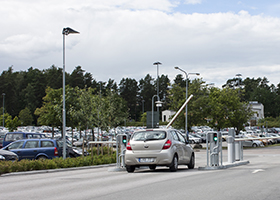Research demonstrates that it is possible to predict the need for parking in connection with renovations and new construction. At the same time, there is a trend towards cities, for example, eliminating street parking and instead using the land for cycling paths, as is the case in Stockholm and Oslo.

“Having a hard time finding parking at work leads to fewer car trips”.
Photo: Karin Linhardt
Alexander Ståhle of the consulting firm Spacescape, who is a researcher at the Royal Institute of Technology in Stockholm, has studied the factors affecting car ownership in Gothenburg and Stockholm. Both cities are undergoing extensive residential construction, and with it discussions of parking needs. He has presented his research at Transportforum.
There are five main factors that count, according to Ståhle: “It’s about the distance from the city, the distance from rail service, residence size, area density, and income.”
These factors can predict car ownership and should, according to Ståhle, determine the “parking norm”, i.e., the municipal rule governing how vehicle parking is to be organized in connection with renovations and new construction. The norm can be stated as the number of parking places per residence.
“However, income must not be overestimated as a factor, and it is important to be open to future uncertain factors, such as autonomous vehicles.”
Parking availability affects car use
Car use is clearly tied to the availability of parking, both where one lives and at one’s destination. Petter Christiansen of the Norwegian Institute of Transport Economics arrived at this conclusion by studying the importance of parking availability at home and the workplace.
“For instance, having a hard time finding parking at work leads to fewer car trips, said Christiansen. The same holds true if parking is scarce near one’s home.”
He also noted that fewer people have access to private parking spaces in major cities, and that car use is also affected by factors such as parking fees and available parking within walking distance. Oslo has implemented a policy intended to limit the number of cars in its downtown area. A highly developed public transport system is often cited as a success factor for such policies. According to Christiansen, however, it is not enough.
“Various restrictions on the supply of parking are needed in addition to good public transport.”
Oslo occupies a special position in Norway, as Stockholm does in Sweden. The parking strategy of the latter was presented by Jonas Eliasson, who splits his time between the municipal administration of Stockholm and the Royal Institute of Technology.
“Stockholm is special. It is very short on space, and there’s an unbelievable amount of construction going on”, said Eliasson.

Photo: Katja Kircher
Many Stockholm residents live in multifamily dwellings, and even though 70–80% have garage parking, many must rely on street parking. At the same time, there is a trend towards deprioritizing parking spaces in favour of bus, bicycle, and pedestrian traffic. However, acceptance of such solutions is relatively strong”, according to Eliasson.
Downtown parking largely comprises pay parking, and now even parking in the suburbs has become pay parking.
“Pleasant cities are cities with fewer cars. Parking and garages are expensive, and we currently face a situation in which those who do not own cars are subsidizing those who have access to parking in or near their multifamily dwellings. We have to ask ourselves how great the demand should be, given the actual cost”.
This article is a report from the VTI conference Transportforum 2017 (session 41). You find more information about the conference here (in Swedish). Text: Johan Granath






Follow us: